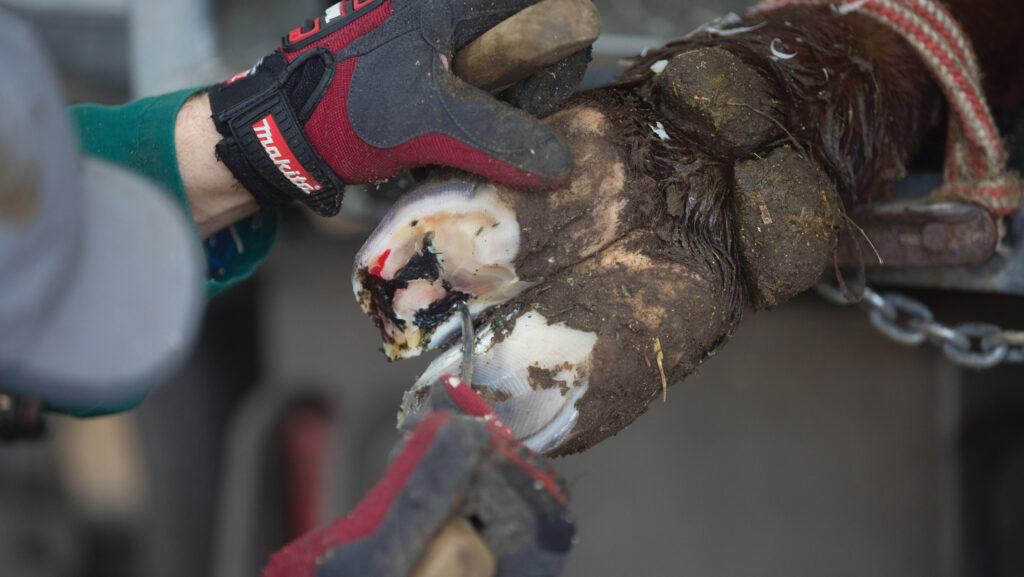Lameness in beef cattle: Effect, causes and treatment
 © Tim Scrivener
© Tim Scrivener Cattle lameness is a significant welfare and economic problem facing the livestock industry.
Most of the focus has been on lameness within the national dairy herd, where there is a lameness prevalence of about 30% (there are numerous research papers that support this figure).
However, when specifically looking at beef cattle, research is far more scarce.
See also: Custom-made cattle handling system improves speed and safety
About the author

Hannah Fitzsimmonds worked as a dairy vet before joining independent vet-owned Torch Farm Vets.
A study by vet Jay Tunstall, published by the University of Liverpool, estimated the mean prevalence of lameness in the UK beef herd at 8.3% in finishing cattle (with a range of 2% to 21.2%) and 14.2% in suckler cows (ranging from 0% to 43.2%).
What is interesting about these figures is the range, with some finisher and suckler cow herds having really low lameness prevalence. This is great, and it shows there are farms that we (as vets and farmers), can learn from to support the reduction of lameness on some holdings with higher lameness levels.
Financial effect of lameness
Lameness is a welfare problem – whatever the initial cause, it is largely a painful condition.
It also affects the efficiency of meat production, with beef finishing cattle in the UK showing an average 240g reduction in daily liveweight gain if they are lame once they are in the finishing period.
This effect is greater if they are lame for a longer proportion of the finishing period.
For example, if an individual finishing animal is lame for 45 days through a 90-day finishing period, it would be 10.8kg lighter at finishing, based on a daily 240g reduction in daily liveweight gain.
At 474.2p/kg, the farmer could be expected to lose £51.21 on that beast.
Scaled up, there could be a £9.05m/year loss to the beef industry if 8.3% of finishers are lame for 45 days in their finishing period.
And these costs are just looking at the finishing period; the true cost of lameness in suckler herds is not yet known, nor how lameness affects conception rates, calving intervals or calf growth rates.
However, work done in the dairy industry has shown there is a strong link between poor mobility and poor fertility.
What is causing the lameness?
The University of LIverpool research showed that for sucklers and finishers, having a white line disease lesion or overgrown claws are two major causes of lameness.
Digital dermatitis can, anecdotally, be an important cause of lameness to get on top of in some beef herds.
Which lesion type your cattle most commonly develop is vital information to know, as this helps us make changes to prevent those lesion types developing in the future.
In terms of risk factors, finishing cattle on slatted flooring could increase the likelihood of them becoming lame, and lameness risk increases with age.
The breed of beef animal slightly alters the risk, with Charolais reported to have a higher predisposition to lameness.
If you spot a lame animal, identifying the cause and providing effective treatment in a prompt manner – ideally in the first few days – will not only be most beneficial for the individual, but also increase the chance of improving the lameness and reduce the likelihood of recurrence.
Many of the lesions causing lameness do not require injectable antibiotics. Instead, remedial trimming, applications of blocks, pain relief and topical antibiotics (in various combinations) can provide effective treatment for most lesion types.
Handling facilities
Having the means to safely lift all four feet for inspection is important: while hind limb lameness is more common, we see more lameness in front feet in beef cattle than their dairy counterparts. Why this is has not yet been established.
If the farm crush is not up to the task, or the handling facilities make it a pain to get cattle to the crush – especially if they are out at grass – lifting a foot becomes a much more challenging job.
However, these difficulties should not be used as an excuse for why lame animals are not being appropriately managed.
It is important to remember that, in line with the Welfare of Animals (Transport) (England) Order 2006, livestock must be able to walk independently on all four feet, without pain that limits their movement, to market or the abattoir.
Identifying and effectively treating an animal quickly reduces the likelihood of chronic lameness developing, which could otherwise limit future movement of that individual, reducing the efficiency of the beef system.
Practical tips for reducing lameness in the beef herd
● Use herd health planning time with the vet to look at the beef herd with a pair of fresh eyes. This will help to establish a benchmark figure of lameness
● Farmers in England can use the Animal Health and Welfare Pathway grant to work with your vet on lesion identification and treatment protocols
● Attend a foot first aid course, run by many vets across the country, to refresh your knowledge and upskill for when you are trimming your cattle’s feet
● Make use of the various grants available to upgrade handling facilities for safe examination of all four feet so you can treat lame cattle promptly
● Enroll the services of a qualified foot-trimmer (check the Cattle Hoof Care Standards Board or National Association of Cattle Foot Trimmers for locating qualified trimmers), especially if handling facilities are a challenge or there are several cattle to examine
